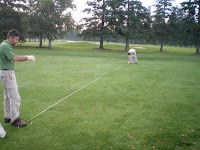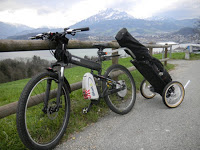
Gabriel S. Delgado C. / CC BY 2.0)
Do you have any idea how many golf courses are in the United States? You can find out easily – just conduct a simple search on our courses and golfers page.
If you only select “USA” as your country and hit search, you will get 725 pages worth of courses with 25 courses per page. Some quick math will tell you that adds up to 18,125 golf courses in the US.
Do you have any idea how big that number is? Well, let me help put it in perspective for you: How long will you drive down the main drag of any city or town in America before you pass a McDonlad’s? Not very long, right? Well, there are only 12,804 Mickey D’s in the United States.
Does that help you wrap your head around 18 thousand f’ing golf courses? Let me ask you something else: What the hell is this country doing with 18,000 golf courses? There’s only 50 states for goodness sake! That’s nearly 400 courses per state! I can understand a state the size of Texas having hundreds of courses (actually has 940), but why does my pea-sized home state of Connecticut have hundreds (199 to be exact)?
The way I see it, having this many golf courses poses a couple problems: First, there’s the negative environmental impact. In the U.S. (which is home to more than half the world’s courses), golf is played on nearly 2 million acres of land. That land requires more than 2 billion* gallons of water daily to be kept green. In addition, vast tracts of natural habitats are being displaced.
In Wyoming in 2004, for example, bald eagles in the region were driven from their nests to accommodate a new golf course just outside of Jackson Hole – an area already established as a golfing mecca.
But giving the middle finger to wildlife is only part of golf’s environmental problem – every year, millions of pounds of pesticides are used on courses in the US. And there’s runoff of those chemicals into our rivers and streams – water that will eventually contaminate wildlife, plant life, and human life.
If this wasn’t bad enough – let’s look at the second problem I have with America’s overabundance of golf courses: It simply isn’t good for the game. The reality is (to quote a post I wrote over a year ago) “every year since 2006, more golf courses have closed in the U.S. than have opened.”
We over-did-it. A decade ago, new courses were springing up everywhere. Now, they’re closing – And struggling private courses are opening their doors to the public in an effort to stay afloat.
Cost-saving measures include squeezing in as many tee-times as possible and trimming staff (course rangers in particular). Both of the aforementioned steps have contributed to slow play (a turn-off for both new and established golfers alike).
Look, I love golf (if you’ve read this blog before, I think it’s obvious) – but don’t you think 18,000 courses is spreading this game a little thin? In this post-Tiger era (and let’s face it, it’s definitley post-Tiger), interest in the game has waned somewhat – we can no longer afford to maintain (successfully anyway) all these tracts of land.
Perhaps a small downsize would be good for golf. Lord knows if our gluttony continues…”Be not among winebibbers; among riotous eaters of flesh: For the drunkard and the glutton shall come to poverty: and drowsiness shall clothe a man with rags.” – Proverbs 23:20-21.
*Corrected Figure (this post originally stated 4 billion gallons of water per day).



I like you post , Keep updating..
inverary hotels
yes, all true. But one must recognize the distinction between all those new golf courses built as part of housing developments or planned communities during the building boom years, versus older, established courses. The older courses are located near population centers where they serve a lot of people, and they are booked solid. The newer ones are shutting down because they were only created to increase the value of the properties being sold in the area. They were ill-conceived from the start, having not considered the demographics.
1. I would like to see the scientific studies your comments about pesticide runoff and water use are based on. Pesticides are designed to stick where they are applied, otherwise they wouldn’t work.
2. I think that for the most part, the open space of a golf course provides a more beneficial wildlife habitat than that same space if it were a strip mall or housing development.
3. If you are concerned about slow play, you should want more golf courses near you rather than less to spread out the crowds.
@Will – great questions!
1. See http://www.beyondpesticides.org/golf/index.htm – particularly the link to the Golf Digest “How Green is Golf” piece from 2008.
2. Keep in mind not all golf course land is zoned for housing or retail space. But I agree with you – I’d rather look at a course than a strip mall!
3. Having more golf courses does not alleviate slow play – better staffed and financially secure golf courses do. Reduce the amount of courses and we create a better experience at those that remain.
1. Mistakes happen. It’s a terrible thing, much less frequent I suspect due to the enormous amount of education, and design of equipment and containers, but it can happen. Go to Google News and type in pesticide golf spill -gulf. It happens and people get severely punished for their mistakes.
As far as traces of active ingredients being found in water samples I’ve seen it twice, one from a golf course (lower than allowable levels deemed safe by gov) and one from a neighboring farm (I suspect) coming in to a golf course. The difference is that the golf course implemented 3 things to prevent it from happening (drift controls, lower rates in subject areas, increased bufferzones), the farm? didnt even know because they were not the ones testing. Telling?
Regardless of “scientific studies” what people believe is true mind as well be true, thats the reality we live in.
2.Its hard to measure the wildlife displacement issue, sure, seagulls and canadian geese may flourish, but where are the scarlett tanagers and salamanders (interior species). Its a case by case issue that is subjective because there is no easily applied metric, with that said common sense should prevail.